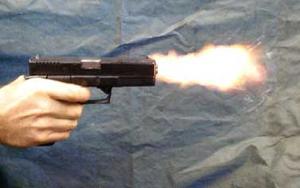What Can Investigators Really Tell From Gunshot Residue?
 |
| www.homelandsecuritynewswire.com
When someone fires a gun, burnt particles from the
bullet spray out of the weapon onto a shooter's
hand, clothes, furniture and other surfaces nearby.
|
Are we getting close to the day when gun fire residue can be analysed on site? Perhaps. But this new method cuts valuable time off the analysis of fire arms residue, and can identify the chemical make up of residue either identifying or eliminating ammunition types used in a crime.
Here's the story:
Real-life CSI: What can investigators
really tell from gunshot residue?
The popular TV series "CSI" is fiction, but every day, real-life investigators and forensic scientists collect and analyze evidence to determine what happened at crime scenes. In a study published in the ACS journal Analytical Chemistry, scientists say they have developed a more rapid and accurate method that could allow crime scene investigators to tell what kind of ammunition was shot from a gun based on the residue it left behind.
Igor K. Lednev and Justin Bueno point out that when someone fires a gun, burnt particles from the bullet spray out of the weapon onto a shooter's hand, clothes, furniture and other surfaces nearby. The presence or absence of that residue says whether a gun was discharged and -- based on its location on clothing and other surfaces -- who and what was near the weapon when it was fired. But current analysis methods can only re-create a crime scene story in hazy detail.
 |
| Suggested reading |
They developed a novel approach to improve gunshot residue "fingerprinting" that can rapidly detect a wider range of particles than existing methods. "Therefore the ability to detect these chemicals may indicate that a specific ammunition brand was discharged (or was not) during a shooting incident," the researchers state, adding that their work could also have applications in the fields of homeland security and counter-terrorism.
Related posts:
- Guilt vs. Shame Predict Criminal Re-offense
- Inside the Minds of Murderers
- It's Getting Harder to Hide Murder
- Killing for Money: Does Crime Pay?
- The Last Meal Test of Innocence
- Our broken, unfair prison system. Is there a better way?
- People Can 'Beat' Guilt Detection Tests
- Plotting Crime Through the Eyes of Burglars
- Questioning Longstanding Forensic Identification
- Three on Crime: Lone Wolf Terrorism; Solitary Confinement; Mental Illness & Violence
- How Visiting High Crime Neighborhood Effects People
- Where have all the burglars gone
* * * * *
Story Source: Materials provided by American Chemical Society. Justin Bueno, Igor K. Lednev. Attenuated Total Reflectance-FT-IR Imaging for Rapid and Automated Detection of Gunshot Residue. Analytical Chemistry, 2014
Comments
Post a Comment